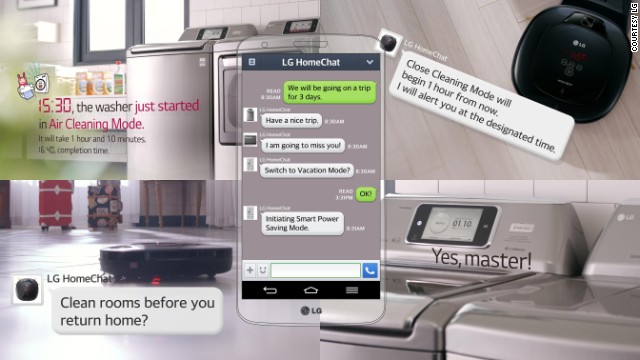Exciting or frightening,
these connected devices of the futuristic "smart" home may be familiar
to fans of science fiction. Now the tech industry is making them a
reality.
Mundane physical objects
all around us are connecting to networks, communicating with mobile
devices and each other to create what's being called an "Internet of
Things," or IoT. Smart homes are just one segment -- cars, clothing,
factories and anything else you can imagine will eventually be "smart"
as well.
But there's a catch: So
far, most Internet of Things products have been a messy tangle of
different wireless protocols and brands. Many can communicate with their
own apps and ecosystems but haven't found a way to play nice with each
other. The Nest thermostat, which can adapt to your energy-consumption habits, is just one example.
These standalone devices
and ecosystems are running their own proprietary software and speaking
different languages. Your smart toaster is humming along in French, for
example, while your fridge is babbling about dairy expiration dates in
Japanese.
 Google's plan for world domination
Google's plan for world domination
Now chipmaker Qualcomm is
trying to give the industry a major push with an open-source project
that can link all these disparate pieces. Qualcomm is hoping its platform, called AllJoyn, could act as a sort of universal translator for the industry.
Over the past four years,
Qualcomm has been working on its AllJoyn protocol to connect devices
from different manufacturers, even if they have different communication
standards. It wants to be the de facto language your fridge, lightbulbs
and garage door all use to communicate.
"The only way that vision
can be realized is if we turn this into a true panindustrial effort
with companies all over the world," said Liat Ben-Zur, Qualcomm's senior
director of product management.
Choosing a standard
Many standards already
help smart devices communicate, though none has emerged as a dominant
option yet. Some companies, such as SmartThings, Lowes and Revolv, depend on a physical hub to link devices.
Experts say this market
will struggle to really take off until someone can convince the major
players it's in their best interest to work with other brands.
"We could see a few
large ecosystems emerge for (the Internet of Things), such as we have
today with Android, iOS and Windows. But consumers like to have choices
and will demand that closed systems learn to communicate with each
other," explained Karen Bartleson, president of the IEEE Standards
Association.
If there are too many
different ecosystems, people will find a way to connect them -- much
like how the problem of multiple phone chargers is being solved by
micro-USB, she said.
"Because (the Internet
of Things) is so vast and varied, it will be hard to come up with a 'one
size fits all' standard," said Bartleson. "Instead of a single,
dominant communication standard for IoT, there will likely be several
that serve different purposes."
A company with as much
industry clout as Qualcomm might have luck bridging some of the gaps.
It's a smart business move: The wireless technology giant makes many of
the chips found in smartphones and tablets. It also sells the chips that
will go inside smart thermostats, security systems, cars and everything
else.
But the connected-things
revolution will only work if all the companies and products find a way
to break out of their silos and work together, according to Ben-Zur.
"Oftentimes we kind of
think about the evolution of the Internet in two revolutions. The first
revolution was the connected Internet," she said. "The second kind of
revolution was when we suddenly went to the mobile Internet."
Being able to access the
Internet from our pockets isn't just revolutionary because it is
portable. The devices collect and share information about us using
built-in sensors, such as accelerometers and GPS. The Internet becomes a
two-way street where we share context about our location, environment
and habits so it can serve up customized information.
A third revolution
Ben-Zur predicts the
Internet of Things will be the third revolution. Sensors will show up in
more and more devices and turn them into sponges that soak up data
about our habits, environment, movements and health.
A smart smoke detector,
for example, might also gather information about the pollen count in a
house. A home security system's motion detectors can track a family's
movements and location over time, sharing information with a central
heating or cooling system to customize each room's temperature.
But it's still to early
to say for sure how all these devices will chat with each other and
whether Qualcomm's AllJoyn or some other option will take off.
The exact killer apps
for the Internet of Things are also a mystery. We won't really know how
the technology will change our lives until we get it into the hands of
creative developers.
"The guys who had been
running mobile for 20 years had no idea that some developer was going to
take the touchscreen and microphone and some graphical resources and
turn a phone into a flute," Ben-Zur said.
The same may be true when developers start experimenting with apps for connected home appliances.
"Exposing that, how your
toothbrush and your water heater and your thermostat ... are going to
interact with you, with your school, that's what's next," said Ben-Zur.

0 comments:
Post a Comment